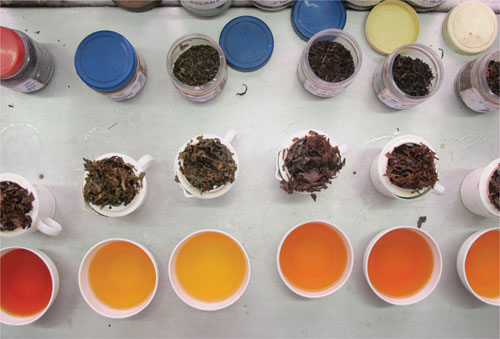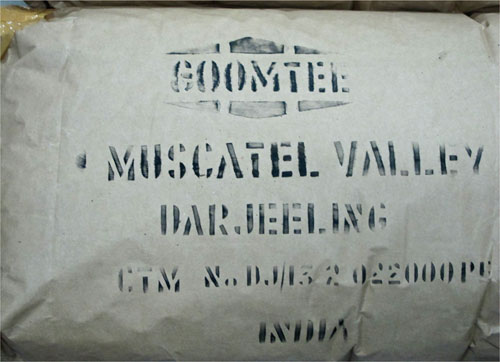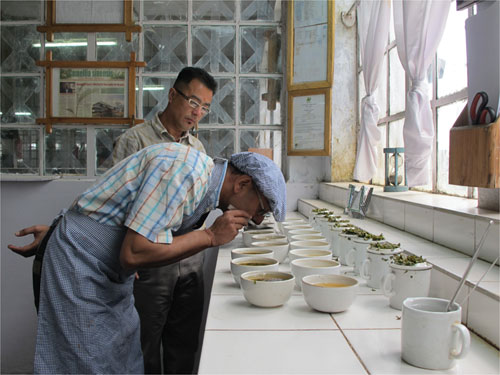Authors: Jeff Koehler
Darjeeling (52 page)
Plucking in Darjeeling is highly selective, can only be done by hand, and is made more challenging by the steep terrain. The average plucker produces under four hundred pounds of finished tea a year, less than a quarter of one in Assam.

After being weighed, freshly plucked tea leaves are withered overnight in long, narrow wooden troughs where they lose about two-thirds of their moisture. H. R. Chaudhary checks the leaves on Namring Tea Estate to see if they are ready to be rolled.

Rolling the withered leaves initiates the fermentation (or oxidation) process by rupturing the cells and releasing the natural juices of the leaves. When exposed to the air, they begin to oxidize, which acts as a catalyst for the characteristics associated with Darjeeling tea.

Once the leaves have been rolled, they are spread out on fermentation beds where they develop their pungency, strength, and aroma. Determining when the leaves have reached their peak and when the fermentation process needs to be immediately halted by firing them in a dryer is the most critical part of tea making.

The liquor—the infused liquid—of Darjeeling tea changes in color throughout the year. First flush teas are pale gold, often with a hint of green.

A range of second flush and monsoon teas on Goomtee Tea Estate. The liquor has deepened in color to amber, copper, and tawny. Teas from the final flush in autumn tend to be ruddy copper, bright auburn, or even burgundy.

A hand-stenciled sack of tea on Goomtee Tea Estate

Vijay Dhancholia conducts a daily tasting on Marybong Tea Estate with the assistant manager, Normal Chhetri.

Girish Sarda at Darjeeling’s storied tea store Nathmulls. Opened in 1931, Nathmulls sells around 150 different Darjeeling teas.

Christened “Tea Deva” by Rajah Banerjee when first found on Makaibari Tea Estate, the insect mimics a tea leaf.

The verandah of the Planters’ Club. Today it is officially known as the Darjeeling Club.
Bloomsbury USA
An imprint of Bloomsbury Publishing Plc
1385 Broadway 50 Bedford Square
New York London
NY 10018 WC1B 3DP
USA UK
BLOOMSBURY and the Diana logo are trademarks of Bloomsbury Publishing Plc
First published 2015
© Jeff Koehler, 2015
All rights reserved. No part of this publication may be reproduced or transmitted in any form or by any means, electronic or mechanical, including photocopying, recording, or any information storage or retrieval system, without prior permission in writing from the publishers.
No responsibility for loss caused to any individual or organization acting on or refraining from action as a result of the material in this publication can be accepted by Bloomsbury or the author.
ISBN: HB: 978-1-62040-512-3
PB: 978-1-62040-513-0
ePub: 978-1-62040-514-7
Library of Congress Cataloging-in-Publication Data
Koehler, Jeff.
Darjeeling: the story of the world’s greatest tea in four harvests / Jeff Koehler.—First U.S. edition.
pages cm
Includes bibliographical references and index.
ISBN 978-1-62040-512-3 (hardcover) – ISBN 9781620405130 (paperback) – ISBN 978-1-62040-514-7 (ebook)
1. Tea trade—India—Darjeeling (District)—History. 2. Tea—India—Darjeeling (District)—History. I. Title. HD9198.I42K64 2015
338.1′7372—dc23
2014033312
To find out more about our authors and books visit
www.bloomsbury.com
. Here you will find extracts, author interviews, details of forthcoming events and the option to sign up for our
newsletters
.
